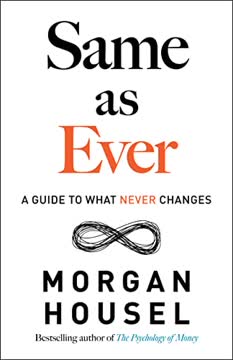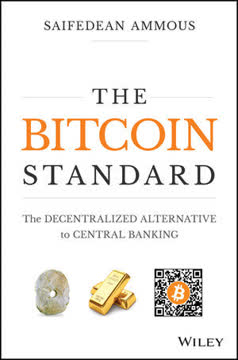Key Takeaways
1. Money evolved from ledgers to commodity-based systems, with gold emerging as the dominant form
"Gold has maintained a stock-to-flow ratio of between 25x and 100x throughout modern history, generally averaging around 50x or above, and briefly falling no lower than 16x during the Gold Rush in the mid-19th century."
Origins of money. Money began as simple ledgers in ancient civilizations, evolving into commodity-based systems as trade expanded. Various items served as proto-money, including shells, beads, and salt. Over time, precious metals, particularly gold and silver, emerged as dominant forms of money due to their scarcity, durability, and divisibility.
Gold's supremacy. Gold ultimately won out over other commodities because:
- Highest stock-to-flow ratio (annual production/existing supply)
- Durability and resistance to corrosion
- Dense value relative to size and weight
- Global recognition and acceptance
Monetary attributes. Ideal money should be:
- Divisible
- Portable
- Durable
- Fungible
- Verifiable
- Scarce
2. Banking innovations centralized control of money and increased the speed gap between transactions and settlements
"The combination of these actions shows why the question of 'who controls the ledger' is very important. It also shows how quickly the answer to the question can change."
Banking evolution. The development of banking systems, including double-entry bookkeeping and fractional reserve banking, led to increased centralization of money control. Key innovations:
- Proto-banking and hawala systems
- Double-entry bookkeeping in Renaissance Italy
- Fractional reserve banking
- Central banking
Speed gap emergence. The invention of telecommunication systems in the 19th century created a significant gap between the speed of transactions and settlements:
- Transactions could occur at the speed of light
- Physical gold settlements remained slow
- This gap empowered banks and central banks
- Led to increased abstraction and financialization of economies
3. Global monetary orders shifted from gold standards to fiat currencies, concentrating power in central banks
"By 1999, Switzerland was the longest remaining country on a gold standard, having dropped their gold standard in 1999. In most of the world it was gone far earlier during the 20th century."
Gold standard era. The international gold standard dominated from the 1870s to World War I, providing a stable global monetary system. Key features:
- Currencies pegged to specific amounts of gold
- International trade settled in gold
- Limited ability for governments to manipulate money supply
Bretton Woods system. Post-World War II, the Bretton Woods system established:
- U.S. dollar as world reserve currency
- Dollar pegged to gold at $35/oz
- Other currencies pegged to the dollar
Fiat currency era. The collapse of Bretton Woods in 1971 led to the current fiat currency system:
- No backing by physical commodities
- Central banks have full control over money supply
- Increased monetary flexibility for governments
- Persistent inflation and currency devaluation
4. Fiat currency systems lead to persistent inflation and financialization of economies
"By hand-waiving away precious metals or any sort of natural constraint as an unnecessary or clumsy way to maintain discipline of the public ledger, they miss a key aspect of why commodity monies have stood the test of time for thousands of years: because nobody can instantly make more of them even when they have a seemingly good reason to do so."
Inflationary bias. Fiat currency systems inherently lead to persistent inflation:
- Central banks target positive inflation rates (e.g., 2% annually)
- Money supply grows faster than economic output
- Purchasing power of currencies decreases over time
Financialization effects:
- Increased speculation and asset bubbles
- Shift from productive investments to financial engineering
- Growing wealth inequality
- Monetization of previously non-monetary assets (e.g., real estate)
Long-term debt cycles. Fiat systems enable the buildup of unsustainable debt levels:
- Private sector debt accumulation during economic expansions
- Public sector debt expansion during crises
- Eventual debt restructuring or inflation to reduce debt burden
5. Bitcoin represents a revolutionary, decentralized form of digital money resistant to censorship and debasement
"Bitcoin is a distributed public ledger that some people have referred to as 'triple entry bookkeeping.' It's a protocol that allows all participants around the world to come to a consensus on the state of the ledger every ten minutes on average."
Bitcoin's key innovations:
- Decentralized, peer-to-peer digital cash system
- Solves the double-spending problem without intermediaries
- Fixed supply of 21 million coins
- Proof-of-work consensus mechanism
Bitcoin as digital gold:
- High stock-to-flow ratio
- Censorship-resistant
- Globally accessible
- Easily verifiable and divisible
Monetary policy:
- Predetermined issuance schedule
- Block reward halving every ~4 years
- Decreasing inflation rate over time
6. The Lightning Network and other layers built on Bitcoin enhance its scalability and utility
"The Lightning network is a series of 2-of-2 multi-signature smart contracts that run on top of the Bitcoin base layer. These channels are peer-to-peer and can support many transactions over time for each base layer transaction."
Lightning Network benefits:
- Enables fast, low-cost micropayments
- Increases Bitcoin's transaction throughput
- Enhances privacy for small transactions
- Allows for machine-to-machine payments
Other Bitcoin layers:
- Sidechains (e.g., Liquid Network)
- Federated networks (e.g., Fedimint)
- Smart contract platforms (e.g., RSK, Stacks)
Layered scaling approach:
- Preserves base layer decentralization and security
- Allows for different optimizations at each layer
- Mimics structure of traditional financial systems
7. Proof-of-work consensus provides Bitcoin with an unforgeable history, unlike proof-of-stake systems
"Energy expended per block not only secures the UTXOs [transactions] belonging in that block but also retroactively secures all global UTXOs that occurred in past blocks. The reason for this is because it would be impossible to revert past UTXOs without reverting the current block first. Each new block effectively 'buries' all existing UTXOs under its weight."
Proof-of-work advantages:
- Creates an unforgeable, objective history
- Requires real-world resources (energy) to secure the network
- Resistant to Sybil attacks and collusion
- Allows nodes to leave and rejoin without trust
Proof-of-stake limitations:
- Relies on circular logic for determining the correct chain
- More complex and prone to centralization
- Lacks unforgeable costliness in its history
- Requires ongoing trust in the network
Importance of energy input:
- Serves as a neutral arbiter of truth
- Connects the digital realm to physical reality
- Enables truly decentralized consensus
8. Bitcoin's energy usage is limited by its utility and primarily consumes stranded energy resources
"Bitcoin's energy usage in the long run is strictly limited by the utility it provides to users, and that Bitcoin primarily consumes stranded energy that would otherwise be wasted."
Energy usage constraints:
- Miner revenue (block subsidies + transaction fees) limits total energy expenditure
- Declining block subsidy reduces Bitcoin's energy intensity over time
- Long-term energy usage will be determined by transaction fees and network adoption
Stranded energy utilization:
- Bitcoin miners seek out cheapest available electricity
- Often use excess renewable energy or flared natural gas
- Can improve grid stability and incentivize renewable energy development
Energy usage context:
- Currently less than 0.1% of global energy consumption
- Comparable to or less than many other industries (e.g., gold mining, banking system)
- Potential for increased efficiency through layer-2 solutions and technological improvements
Last updated:
FAQ
What's Broken Money about?
- Historical Evolution: Broken Money by Lyn Alden explores the historical evolution of money, from ancient ledgers to modern financial systems, and examines why certain commodities like gold and silver became dominant.
- Critique of Current Systems: Alden critiques the current financial system, highlighting the issues with fiat currencies, such as inflation and devaluation, and argues for a reevaluation in light of technological advancements.
- Future of Money: The book speculates on the future of money, particularly with the rise of cryptocurrencies and digital currencies, and discusses their potential to address the shortcomings of current systems.
Why should I read Broken Money?
- Informed Perspective: The book provides a comprehensive understanding of money's workings and historical context, helping readers make informed financial decisions.
- Critical Analysis: Alden offers a critical analysis of the financial system, challenging conventional wisdom and encouraging readers to think critically about monetary policies.
- Practical Implications: The book discusses the practical implications of monetary systems on everyday life, empowering readers to navigate financial challenges effectively.
What are the key takeaways of Broken Money?
- Nature of Money: Money serves as a ledger, tracking value and transactions, with consistent properties throughout history despite changes in form.
- Impact of Technology: Technological advancements have historically influenced money's nature, and the current system needs to adapt to modern technologies like cryptocurrencies.
- Consequences of Fiat Systems: Fiat currencies pose risks like inflation and economic instability, prompting a need to consider alternatives for savings and investments.
What are the best quotes from Broken Money and what do they mean?
- "Money is a ledger.": This quote encapsulates the book's theme that money is fundamentally a record of transactions and value, emphasizing its societal role.
- "The financial system as we know it isn’t working anymore.": Alden critiques the current system's failure to meet economic needs, urging a reevaluation of fiat currencies.
- "Politics can affect things locally and temporarily, but technology can affect things globally and permanently.": This highlights technology's transformative power in shaping monetary systems, suggesting cryptocurrencies' potential impact.
How does Lyn Alden define money in Broken Money?
- Core Definition: Alden defines money as a ledger system for recording transactions and value, crucial for understanding its historical purpose.
- Properties of Effective Money: Effective money is portable, divisible, durable, and scarce, determining which forms succeed historically.
- Commodity Money: Alden views commodity money, like gold, as governed by natural laws and scarcity, contrasting with fiat money's arbitrary nature.
What historical examples does Broken Money provide?
- Ancient Ledgers: The book discusses ancient Mesopotamian clay tablets as early ledgers, foundational to modern money.
- The Gold Standard: Alden examines the gold standard's rise and fall, highlighting its role in monetary stability and fiat currency volatility.
- Hyperinflation Cases: Examples like Zimbabwe and Venezuela illustrate fiat currencies' dangers and poor monetary policies' consequences.
How does Broken Money address the future of money?
- Rise of Cryptocurrencies: Alden explores cryptocurrencies like Bitcoin as alternatives to fiat currencies, analyzing their potential to address current system shortcomings.
- Decentralized Finance (DeFi): The book discusses DeFi's implications for banking and money, suggesting it could provide more equitable financial access.
- Technological Innovations: Alden emphasizes blockchain and digital currencies' role in creating efficient, stable monetary systems.
What is the Cantillon Effect mentioned in Broken Money?
- Definition: The Cantillon Effect describes how changes in money supply affect different groups unevenly, benefiting those closest to new money first.
- Impact on Wealth Distribution: This effect contributes to wealth inequality, as those with early access to new money benefit from rising asset prices.
- Historical Context: Alden provides historical examples, linking the Cantillon Effect to modern monetary policies and socioeconomic impacts.
How does Broken Money critique central banking?
- Centralization of Power: Alden critiques central banking for concentrating monetary power, leading to poor decision-making and instability.
- Inflationary Policies: Central banks' inflationary policies erode purchasing power and savings, highlighting risks in relying on them for stability.
- Lack of Accountability: The book emphasizes central banking's lack of accountability, urging consideration of alternative monetary frameworks.
What solutions does Broken Money propose for the current financial system?
- Adoption of Sound Money: Alden advocates for sound money principles, suggesting commodity-backed currencies for economic stability.
- Decentralized Alternatives: The book encourages exploring decentralized financial systems and cryptocurrencies to enhance inclusion and reduce centralization.
- Reform of Banking Practices: Alden calls for banking reforms to promote transparency and accountability, aiming for a resilient financial system.
How does Lyn Alden explain the relationship between fiat currency and inflation in Broken Money?
- Inflation as a Feature: Inflation is inherent in fiat systems, as governments can print money, eroding purchasing power.
- Impact on Savings: Inflation affects savers in fiat currencies, prompting a need for alternatives that preserve value.
- Historical Examples: Alden provides historical context, illustrating fiat currencies' flaws and the urgency for sound money alternatives.
What role does Bitcoin play in the future financial system according to Broken Money?
- Decentralized Alternative: Bitcoin serves as a decentralized alternative to fiat currencies, offering a stable store of value.
- Global Payment System: Bitcoin facilitates global transactions without intermediaries, democratizing financial access.
- Long-term Viability: As fiat limitations become apparent, Bitcoin's adoption could reshape the financial landscape, challenging existing systems.
Review Summary
Broken Money by Lyn Alden receives high praise for its comprehensive exploration of monetary systems, from ancient times to modern cryptocurrencies. Readers appreciate Alden's clear explanations of complex financial concepts, her balanced approach to discussing Bitcoin, and her insights into the flaws of current fiat systems. The book is lauded for its accessibility to both novices and experts, though some find the Bitcoin sections less convincing. Overall, it's considered an essential read for understanding money's past, present, and potential future.
Similar Books






Download PDF
Download EPUB
.epub digital book format is ideal for reading ebooks on phones, tablets, and e-readers.





